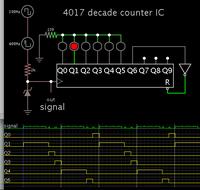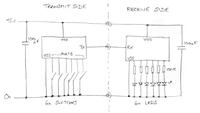Jonathan David Bond
Junior Member level 3

Dear EDA Board, this is my first post (please be gentle). I hope I've put this in the correct place.
I have a very rudimentary understanding of components and am a bit of a kludge with a soldering iron, but I like to try things.
I am in the process of "electrifying" a tabletop game.
One of the playing pieces will have 6 lamps (either LED or model train style micro incandescents).
Wanting to make the pieces as easy to move as possible without breaking anything, and making then omni-directional I plan to plug them into the game board using mono/stereo jack plugs. However this restricts me to 2 or 3 connection, not the 7 (6 lamps and common ground) I need.
The 6 lamps are independently controlled by switches (on/off) to make varying different patterns.
Is there a pair of small (8 pin?) IC's I can use to take the 6 individual switch inputs (encode) and relay them to the piece (decode) over the 2/3 lines?
Obviously 1 of the IC's (decode) has to reside inside the piece, so they need to be the smallest possible.
I have a very rudimentary understanding of components and am a bit of a kludge with a soldering iron, but I like to try things.
I am in the process of "electrifying" a tabletop game.
One of the playing pieces will have 6 lamps (either LED or model train style micro incandescents).
Wanting to make the pieces as easy to move as possible without breaking anything, and making then omni-directional I plan to plug them into the game board using mono/stereo jack plugs. However this restricts me to 2 or 3 connection, not the 7 (6 lamps and common ground) I need.
The 6 lamps are independently controlled by switches (on/off) to make varying different patterns.
Is there a pair of small (8 pin?) IC's I can use to take the 6 individual switch inputs (encode) and relay them to the piece (decode) over the 2/3 lines?
Obviously 1 of the IC's (decode) has to reside inside the piece, so they need to be the smallest possible.




